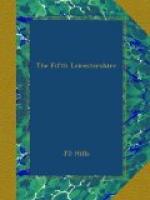It had rained hard throughout the relief, but our first two days in the line were dry and warm, and we managed to dry our clothing and make ourselves fairly comfortable. The enemy after the failure at Oppy was very quiet on our front, though his documents captured in that battle showed that, had he succeeded in his first day’s attempt, the second day was to include an attack on the Hulluch front. So the “state of readiness” in the Cambrin sector had not been entirely without justification. On the 31st the weather broke again, but this did not prevent the Padre holding his Easter services at each of the Company Headquarters. The following evening we relieved the 5th Lincolnshires in the “Hill 70” right sub-sector.
Our new sector was very much the same as the “Hill 70 left,” which we had held in November. The reserve line was the main line of defence, and was in fairly good condition; the front line was shallow, wet, and dangerous. Opposite our right and centre was Cite St. Auguste, strongly held by the enemy; opposite the left, Bois “Dixhuit” and a broken down farm. There was one tunnel, “Hythe,” leading from the reserve line to a railway cutting in the front line, but except in cases of extreme emergency this was not intended to be used by the Infantry. Battalion Headquarters occupied a small and evil smelling German dug-out on the reverse slope of the hill. Our tour lasted eight days, and almost every hour was eventful.
We started the tour with a gas bombardment soon after relief on “C” Company’s support platoon, who occupied an old “pill-box” near Cite St. Pierre dynamite magazine. The gas appliances were defective at the dug-out entrance, and several men were slightly gassed. At 8-0 a.m. the following morning, the 11th Division on our left carried out a very successful raid. This did not in itself affect us very much, but a bomb-dropping aeronaut during the raid observed large bodies of troops massing near Meurchin, a large town behind Hulluch. Immediately the old alarm about a coming attack was renewed, and we once more were ordered to be in readiness. However, by evening as nothing had happened, we resumed normal conditions.
This same evening we were given an entirely new scheme of defence, consequent upon the failure of our trench system to stop the enemy’s advance in the South. The front line was to be held by isolated observation posts only, and there was to be no garrison within effective trench mortar range of the enemy. We were to consider the Reserve or “Red” Line the line of defence, and this must be rebuilt if necessary, to ensure that it was everywhere out of reach of the enemy’s minenwerfer. Our chief difficulty was to find accommodation for the front line troops as they were withdrawn; however, we cleared out old dug-outs, and, after a few days of terribly hard work, were able to comply with the order.
Meanwhile, the enemy’s artillery became very active, and in addition to frequent gas bombardments of Loos and the Crassier, he harassed our transport very badly as they came along the main road. Some of this gas blew back over our lines, and for several hours we lived in an atmosphere of gas, scarcely noticeable, but none the less dangerous.




